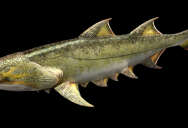Our Earliest Jawed Ancestor Was A Spiky Shark
I don’t know about you, but I feel like there are a good number of people who will love hearing that humans – or at least some of our DNA – was handed down from a pretty cool-looking shark.
The shark in question dates back 439 million years – a surprise, since previously scientists had dated the oldest acanthodian 15 million years younger.

Image Credit: YouTube
This Paleozoic fossil was found in the bone bed of the Rongxi Formation in the Shiqian County of Guizhou Province of South China. It was collected along with multiple other skeletal fragments and pieced back together.
Scientists named the specimen Fanjingshania renovata, and say the fish covered in bony armor and paired fin spines would have looked very different from the sharks we know today.
The authors of the study released a statement that went into the insights they were able to glean from the fossil.
“This is the oldest jawed fish with known anatomy. The new data allowed us to place Fanjingshania in the phylogenetic tree of early vertebrates and gain much needed information about the evolutionary steps leading to the origin of important vertebrate adaptations such as jaws, sensory systems, and paired appendages.”

Image Credit: YouTube
They also say that the fish is exceptional because even though they belong to the chondrichthyans, which are known for their cartilage, Fanjingshania exhibits traits more often seen in bony fish or even mammals.
“This level of hard tissue modification is unprecedented in chondrichthyans, a group that includes modern cartilaginous fish and their extinct ancestors. It speaks about greater than currently understood developmental plasticity of the mineralized skeleton at the onset of jawed fish diversification.”
The discovery basically lends itself to the idea that jawed fish began to evolve 455 million years ago, during the Ordovician.
“The new discovery puts into question existing models of vertebrate evolution by significantly condensing the timeframe for the emergence of jawed fish from their closest jawed ancestors. This will have profound impact on how we assess evolutionary rates in early vertebrates and the relationship between morphological and molecular change in these groups.”
Evolution never ceases to amaze me.

Sign up to get our BEST stories of the week straight to your inbox.




